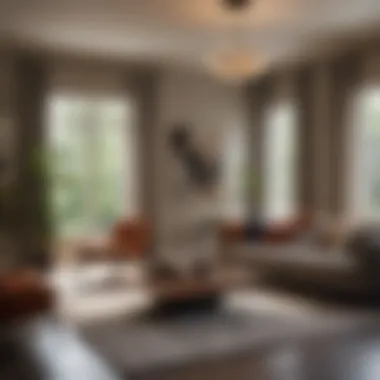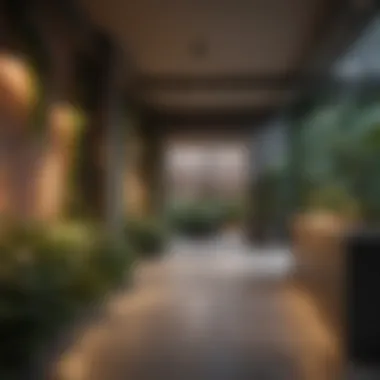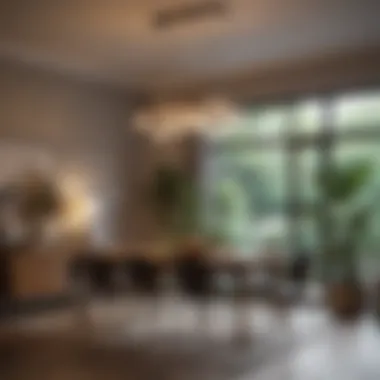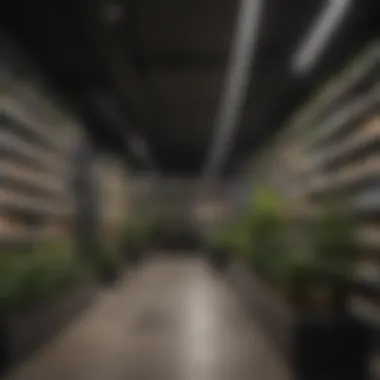Illuminating Spaces: The Power of Dibs Lighting


Intro
The realm of interior design continuously evolves, driven by advances in technology and changing consumer preferences. Among the innovations currently gaining attention is Dibs Lighting. This concept not only enhances visual appeal but also redefines how spaces are utilized and experienced. Homeowners, interior design enthusiasts, and even gardening aficionados can greatly benefit from understanding Dibs Lighting's multifaceted applications. Its integration fosters a blend of aesthetics and practicality, elevating environments to create more enjoyable and functional spaces.
Key Insights and Trends
Dibs Lighting is part of a broader trend focusing on innovative lighting solutions that address both style and functionality. A few elements currently shaping the landscape include:
- Sustainable Solutions: With increasing awareness of environmental issues, sustainable lighting options are on the rise. Dibs Lighting often incorporates energy-efficient technologies like LED systems, merging style with responsibility.
- Smart Home Integration: Home automation is a significant trend. Dibs Lighting can seamlessly connect with home automation systems, allowing users to control ambiance easily through smartphones or voice commands.
- Versatile Designs: The adaptability of lighting fixtures—ranging from ceiling lights to wall sconces—enables homeowners to personalize their spaces effectively. This flexibility keeps the decor dynamic and aligned with individual tastes.
"Lighting plays a critical role in setting the mood and enhancing the functionality of a space."
These insights reveal that Dibs Lighting is not just about illumination; it’s about crafting experiences and enhancing quality of life.
Practical Tips and How-To Guides
To effectively implement Dibs Lighting in your home, consider the following guidance:
- Assess Your Space: Before diving into your project, determine the functions of each area. Consider how lighting can enhance these spaces—dimming options in relaxing areas, bright lighting for workspaces, etc.
- Choose Appropriate Fixtures: Select lights that align with your aesthetic and functional needs. For Dibs Lighting, consider fixtures that can be adjusted for intensity and color.
- Layer Your Lighting: Utilize a combination of ambient, task, and accent lighting. This strategy not only brings depth to your design but also allows you to adjust the atmosphere as required.
- Incorporate Natural Light: Whenever possible, enhance your interior with available natural light. Complement it with Dibs Lighting solutions to reduce energy consumption.
- Stay Updated on Trends: Keep an eye on current trends and technological advancements in lighting. Participate in forums like Reddit or industry platforms to learn and share experiences.
Understanding the principles of Dibs Lighting can greatly influence your approach to interior design. Its integration fosters a balance between style and utility, ensuring every space is both aesthetically pleasing and functionally viable.
Understanding Dibs Lighting
Understanding Dibs Lighting is essential for homeowners and design enthusiasts seeking to enhance their living spaces. This concept goes beyond mere functionality; it encompasses the integral relationship of light to design, mood, and environment. Dibs Lighting plays a crucial role in defining spaces, enhancing aesthetics, and improving overall functionality.
Definition and Concept
Dibs Lighting can be defined as a unique approach to lighting design that emphasizes innovative solutions tailored for specific environments. This concept integrates various lighting types, from ambient to task lighting, in a way that complements the overall design of a space. The focus of Dibs Lighting is to create a harmonious balance between light and space. By carefully selecting and positioning light sources, designers can influence the perception of space and enhance its usability.
The importance of Dibs Lighting lies in its ability to transform interiors, making them not only more appealing but also more livable. The skillful use of lighting can emphasize architectural features, create a sense of warmth, and improve the functionality of a room. Moreover, this approach takes into account modern lighting technologies, making it adaptable to various settings, whether residential, commercial, or outdoor.
Historical Context
The development of Dibs Lighting is rooted in the evolution of lighting technologies and design philosophies. Historically, lighting has been crucial in architecture and interior design. From the earliest candles and oil lamps to today's advanced LED solutions, each stage of development has brought it new possibilities and challenges.
In the 20th century, the advent of electric lighting revolutionized the way spaces were illuminated. This era saw a shift from purely functional light sources to designs that consider aesthetics and emotional responses. Over decades, designers began to appreciate the impact of light on human psychology and mood, leading to the formulation of concepts like Dibs Lighting.
As designers explored the effects of light on space, they began to realize its potential for enhancing experience and influencing behavior.
Today, Dibs Lighting reflects a blend of historical insights and modern innovations. The concept continues to evolve as new technologies emerge and as growing awareness of sustainability shapes consumer preferences. Understanding this historical context helps to appreciate the current trends and future directions in lighting design.
Technical Elements of Dibs Lighting
The technical elements of Dibs Lighting play a crucial role in optimizing both aesthetics and functionality in various environments. Understanding how these components work together can help homeowners and interior designers achieve their desired atmosphere while maintaining efficiency. This section will explore the essential components and materials involved, as well as the recent advancements in lighting technology, providing a comprehensive view of what defines Dibs Lighting.
Components and Materials
Dibs Lighting comprises several critical components that contribute to its efficiency and versatility. The main parts include fixtures, bulbs, and controllers. Each of these elements requires careful consideration when planning a lighting layout.
- Fixtures: The design of fixtures determines how light is distributed throughout a space. Popular materials include metals such as aluminum and brass, glass, and even some biodegradable plastics. These materials not only enhance durability but also provide style and character.
- Bulbs: The choice of bulbs is pivotal in achieving desired brightness levels and color temperatures. This is where LED technology shines. LED bulbs offer significant energy savings and a longer lifespan compared to traditional incandescent lights. They also provide a variety of color options, impacting the mood of any room.
- Controllers: Smart lighting controllers allow for greater customization. These devices enable users to adjust brightness, change colors, and even program schedules. Integration with home automation systems is a growing trend that adds convenience.
Using quality components ensures that the lighting is not only appealing but also energy-efficient. Homeowners should consider how different materials and technologies can blend to fit individual tastes and environmental values.
Lighting Technology Advancements


In the rapidly evolving field of lighting technology, advancements have transformed the way Dibs Lighting is approached. These developments are essential in making lighting more efficient and user-friendly.
One of the most notable advancements is the improvement of LED technology. Today’s LEDs are more powerful while consuming less energy. They also produce less heat, making them safer for various applications. This leads to lower energy bills and a reduced carbon footprint.
Another key advancement is the evolution of smart lighting systems. These systems utilize wireless connectivity and smartphone apps for control. Features like dimming, color changes, and scene setting can drastically improve the user experience. For instance, one can seamlessly transition from bright, focused light for work tasks to softer, ambient lighting for relaxing in the evening.
"Innovations in lighting technology not only enhance aesthetic appeal but also promote sustainability and energy efficiency."
The integration of voice-activated devices further simplifies the operation. Products like Amazon Echo or Google Home can directly control Dibs Lighting systems, making it even more accessible.
In summary, the technical elements of Dibs Lighting, comprised of quality components and innovative technologies, cater to the diverse needs of users. A thorough understanding of these aspects is crucial for achieving a well-lit, functional, and visually pleasing environment.
Design Aesthetics in Dibs Lighting
Design aesthetics in Dibs Lighting is critical because it shapes how spaces are perceived and experienced. Lighting is not just about illumination; it is an integral part of design that can alter the atmosphere and mood of any area. Dibs Lighting, known for its versatility and innovation, offers distinct advantages in terms of style and functionality. Homeowners and design enthusiasts alike must consider how to integrate these lighting solutions to enhance their environment.
Integrating Dibs Lighting in Interiors
Integrating Dibs Lighting into interiors requires careful planning and thought. Use this lighting to highlight architectural features or create points of interest. For instance, pendant lights can draw attention to dining areas or kitchen islands, while wall sconces can add dimension to narrow hallways. Choosing the right placement ensures that the light serves both aesthetic and practical purposes.
Factors to consider when integrating Dibs Lighting include:
- Style compatibility: Ensure that the lighting matches the overall theme of the space.
- Functionality: Consider the task at hand. Different areas require different lighting solutions, whether it is for reading, cooking, or relaxing.
- Layering: Combine ambient, task, and accent lights for a well-rounded illumination.
Color Temperature and Mood
Understanding color temperature is crucial in Dibs Lighting. Color temperature is measured in Kelvins (K) and impacts how we perceive space. Warmer tones (below 3000K) are inviting and cozy, ideal for bedrooms and living rooms. Cooler tones (above 4000K) are energizing and are better suited for kitchens and workspaces. Selecting the right temperature can significantly influence the mood of a room.
Some guidelines for choosing color temperature include:
- Warm light for relaxation in living areas.
- Neutral light creates a balanced environment, suitable for multipurpose spaces.
- Cool light promotes focus and energy, ideal for work environments.
Creating Ambiance with Dibs Lighting
Creating ambiance with Dibs Lighting involves more than just selecting fixtures; it is about utilizing light in a way that enhances the experience of the space. Dimmers and smart lighting systems can adjust brightness levels, allowing for transitions from vibrant activity to restful relaxation.
Key elements to enhance ambiance include:
- Layered lighting: Combining various light sources to create depth.
- Highlighting artwork: Use accent lighting to draw attention to pieces.
- Color control: Changing light hues to match moods or occasions.
"Well-designed lighting not only illuminates a space but also enhances its character and function."
Practical Applications of Dibs Lighting
Dibs Lighting signifies a transformative approach to illumination that extends beyond mere functionality. The practical applications of Dibs Lighting encapsulate how this innovative lighting can enhance various environments, providing not just light but also atmosphere and mood. By understanding its practical uses, homeowners, interior design enthusiasts, and commercial operators can make informed decisions that benefit aesthetics and practicality alike.
Residential Settings
In residential settings, Dibs Lighting can play a pivotal role in enhancing the beauty and functionality of living spaces. Homeowners can utilize Dibs Lighting in several ways:
- Accent Lighting: Dibs fixtures can serve as accent points in rooms, highlighting art pieces or architectural features. A well-placed fixture can create a beautiful focal point that draws the eye without overwhelming the rest of the decor.
- Functional Tasks: In areas such as kitchens and home offices, Dibs Lighting assists in task-oriented areas where visibility is essential. Proper lighting can improve safety and practicality when engaging in daily tasks like cooking or reading.
- Mood Setting: The ability to change color temperature allows residents to tailor lighting to fit the mood, whether for relaxation or activity. Soft, warm light can create a cozy feeling at home, while cooler tones can help energize the environment.
Commercial Spaces
Commercial spaces significantly benefit from Dibs Lighting due to its adaptability and impact on business performance. Here are some key applications:
- Brand Identity: Companies can use Dibs Lighting to reinforce their brand identity. Innovative lighting designs can reflect a brand's ethos and attract target customers, enhancing the overall shopping experience.
- Employee Productivity: Proper illumination contributes to a better working environment. Studies show that well-lit workspaces promote productivity, reduce instances of eye strain, and improve workplace morale. Dibs Lighting options provide the flexibility to adjust brightness levels based on the time of day and activity.
- Customer Engagement: In retail settings, creating atmosphere is crucial to engage customers. Dibs Lighting can be strategically employed to highlight products, draw attention to sales, or create an inviting space that encourages longer visits.


Outdoor Applications
Outdoor lighting applications of Dibs Lighting also warrant attention, emphasizing safety, aesthetics, and functionality. Some practical uses include:
- Safety and Security: Dibs Lighting enhances safety in outdoor areas. By illuminating pathways, driveways, and garden spaces, the risk of accidents decreases during nighttime hours, while also deterring potential intruders.
- Landscape Enhancement: Outdoor spaces can gain significantly from well-placed Dibs fixtures. These can illuminate trees, shrubs, or garden features, thereby enhancing the beauty of outdoor landscapes.
- Social Gatherings: Patios or decks can be transformed into inviting spaces for gatherings and celebrations. Dibs Lighting creates an ambiance conducive to social interactions, thereby extending the usability of outdoor spaces into the evening hours.
Properly applied Dibs Lighting can turn everyday spaces into extraordinary experiences. It is not only about light; it is about creating environments that resonate with the occupants.
Economic Aspects of Dibs Lighting
The economic aspects of Dibs Lighting play a prominent role in understanding its impact on interior design and broader market trends. Assessing these elements is crucial for homeowners, interior design enthusiasts, and other stakeholders who wish to invest in effective lighting solutions. Dibs Lighting not only enhances aesthetic appeal and functionality, but also possesses inherent cost-benefit benefits that can affect decisions related to purchasing and installation.
Cost-Effectiveness Analysis
Evaluating cost-effectiveness is essential when choosing Dibs Lighting as a long-term investment. While initial expenses may vary, many studies indicate substantial savings over time due to energy efficiency. Dibs Lighting solutions often utilize LED technology, which consumes less electricity compared to traditional lighting options. This not only reduces monthly energy bills but also contributes to lower carbon footprints.
Another point to consider is durability. Robust materials used in Dibs Lighting often have increased longevity, leading to fewer replacements and, therefore, less waste. For instance, comparing cost over a decade reveals that the upfront investment in Dibs Lighting may yield significant savings in replacements and maintenance.
In summary, cost-effectiveness is influenced by both immediate costs and long-term savings, making Dibs Lighting a compelling choice for many consumers.
Market Trends and Forecasts
Understanding prevailing market trends and future forecasts is vital for stakeholders interested in Dibs Lighting. Current data suggest a rising demand for energy-efficient and stylish lighting solutions. As environmentally conscious practices become popular and legislation in favor of energy efficiency progresses, the market for Dibs Lighting is likely to expand.
Predictions indicate growth in both residential and commercial applications, especially in urban settings, where efficient use of space and resources is prioritized. The increasing awareness of sustainable living is pushing designers to integrate Dibs Lighting into their plans. This trend creates opportunities for suppliers and manufacturers to meet consumer demands.
Additional factors include technological advancements. Innovations will continue to earn attention among consumers, as features such as smart connections and enhanced control options become standard in new Dibs products. This can lead to increased sales and ongoing interest in the market domain.
"The integration of Dibs Lighting reflects a larger shift towards sustainability and innovation in design. Stakeholders should remain vigilant to capitalize on emerging opportunities and trends in this evolving landscape."
Sustainability in Dibs Lighting
Sustainability in Dibs Lighting is an essential aspect that encapsulates the growing need for environmentally responsible design solutions. The significance of this topic extends beyond aesthetic choices to encompass energy efficiency, ecological impact, and social responsibility. As homeowners and designers seek to create spaces that reflect personal values while minimizing environmental footprint, understanding sustainability in Dibs Lighting becomes essential.
Energy Efficiency Considerations
Energy efficiency is a cornerstone of sustainable lighting practices. Dibs Lighting incorporates advanced technologies that significantly reduce energy consumption. Utilizing LED bulbs is one of the most effective approaches for achieving energy savings. Unlike traditional incandescent lamps, LED lights consume up to 75% less energy and last significantly longer. Additionally, many Dibs Lighting solutions include smart technology, such as motion sensors and programmable timers, allowing users to optimize light usage according to their needs and routines.
Benefits of improved energy efficiency in Dibs Lighting:
- Lower utility costs: By reducing energy consumption, homeowners can see a noticeable decrease in their electricity bills.
- Extended lifespan of lighting fixtures: Energy-efficient systems are designed to last longer, which can reduce maintenance and replacement costs.
- Less heat emission: Unlike conventional lighting, Dibs solutions generate less heat, contributing to a cooler environment and reducing the workload on air conditioning systems.
Impact on the Environment
The environmental impact of lighting is multifaceted, and the choices made in Dibs Lighting can mitigate several negative effects. By prioritizing sustainable materials, the composition of lighting fixtures can minimize waste and resource depletion. Dibs Lighting often sources materials that are recyclable or made from renewable resources. Utilization of such materials ensures that the production process aligns with sustainable practices.
Moreover, adopting energy-efficient lighting significantly reduces greenhouse gas emissions. Traditional lighting methods contribute to higher emissions, largely due to increased energy demand from fossil fuel power plants. Dibs Lighting, with its emphasis on efficiency, can help lower the carbon footprint of households and businesses.
"Sustainable lighting solutions represent a significant leap forward in our quest to balance modern aesthetics with ecological responsibility."
Challenges and Limitations
Understanding the challenges and limitations in Dibs Lighting is essential for anyone considering its application in their spaces. This section delves into the specific hurdles faced by homeowners and designers alike. It highlights the constraints that can impact the usability and acceptance of Dibs Lighting more broadly.
Technical Challenges
Dibs Lighting technology, while innovative, is not without its technical obstacles. Many users might encounter issues related to installation and compatibility with existing electrical systems. For instance, integrating Dibs Lighting with older wiring setups can be complex, often requiring additional modifications. This may lead to increased costs and potential installation delays.


Moreover, the reliance on advanced technology means that any bugs or failures could significantly affect the lighting experience. Users might notice flickering or unresponsive controls, which detracts from the intended convenience of such systems. In addition, technological updates can leave some older systems obsolete. This concern can make homeowners hesitant to invest heavily in Dibs Lighting solutions, knowing that they may need replacements or upgrades sooner than expected.
Market Limitations
On the market side, Dibs Lighting can face limitations that affect its growth. A critical issue is the availability of products. In regions where Dibs Lighting is less known, supply chains may not fully support the demand for diverse products. This can restrict choices for consumers, leaving them with limited options when selecting styles or functionalities.
Alongside limited availability, the costs associated with high-quality Dibs Lighting can inhibit broader market acceptance. For many homeowners, the initial investment can appear steep compared to traditional lighting solutions. This issue often centers on perceived value versus actual benefits. While many see the long-term savings in energy efficiency, the upfront costs can deter spenders.
Furthermore, consumer awareness plays a vital role. Many prospective buyers may not fully understand the advantages of Dibs Lighting, which feeds into uncertainty about making purchases. Education and understanding are key for potential customers. Without this awareness, market penetration remains stunted.
"Understanding the challenges of Dibs Lighting is crucial for successful integration in home and commercial spaces."
In summary, while Dibs Lighting offers innovative solutions for lighting design, both technical challenges and market limitations must be considered. Addressing these issues effectively can open the door for more homeowners and designers to embrace the technology.
Future of Dibs Lighting
The future of Dibs Lighting presents an engaging field that reflects a blend of innovation and practicality within the realm of interior design. As technology advances, so too does the potential for Dibs Lighting to enhance the atmosphere in various settings. This section will explore current trends and forecast developments that promise to shape the landscape of lighting solutions.
Innovations on the Horizon
Innovations in Dibs Lighting are essential for creating a more adaptive and thoughtful environment in homes and public spaces. Several technologies are set to revolutionize how we perceive and use lighting.
- Smart Lighting Systems: The integration of smart lighting allows for customization and control through smartphone applications or voice commands. Homeowners can adjust brightness and color according to their mood or activities.
- Energy-efficient LEDs: Continued advancements in LED technology will yield even more energy-efficient products. Enhanced light output with reduced energy consumption will make Dibs Lighting a sustainable choice for consumers concerned about ecological impact.
- Biophilic Design Elements: The use of natural light and organic shapes in design will play a vital role. Innovations may incorporate features that enhance natural light penetration in spaces, promoting well-being and productivity.
"The integration of smart technology into Dibs Lighting will change how spaces can be illuminated while enhancing overall functionality."
Predicted Market Growth
As the focus on sustainable living and intelligent home solutions grows, the market for Dibs Lighting is expected to witness significant expansion. Several factors contribute to this projected growth:
- Increased Consumer Awareness: A rapid awareness of climate change and energy consumption is pushing consumers towards more energy-efficient lighting solutions.
- Demand for Aesthetics and Functionality: Consumers are looking for products that not only serve a functional purpose but also enhance the visual appeal of their spaces, leading to a rise in demand for unique Dibs Lighting designs.
- Adaptation in Residential and Commercial Uses: An increase in projects that meld residential comfort with commercial efficiency means more opportunities for Dibs Lighting to shine.
The collaboration between technology, sustainability, and design positions Dibs Lighting as a frontrunner in the industry. Its influence will likely inspire new trends and practices, ensuring a bright future for lighting in our daily lives.
Culmination
The conclusion serves as a pivotal section of the article, summarizing the extensive exploration of Dibs Lighting. It reaffirms the significance of understanding this innovative lighting solution, particularly how it integrates within various settings. Through a comprehensive analysis, readers can grasp the multifaceted benefits that Dibs Lighting presents. From enhancing the aesthetic appeal of spaces to improving functionality, the reverberation of effective lighting choices is profound.
As discussed, the economic implications of these lighting solutions demonstrate their cost-effectiveness over time. When contemplating installation, homeowners can evaluate the sustainability aspect, which is increasingly relevant in today’s environmentally conscious market.
Moreover, Dibs Lighting addresses a broad spectrum of applications. The versatility showcased in residential, commercial, and outdoor environments suggests its far-reaching impact.
"Understanding Dibs Lighting allows individuals to make informed choices that enhance both styles and practicality in their spaces."
In essence, the conclusion solidifies the essence of Dibs Lighting as not just a trend, but a substantial move towards an enlightened design philosophy.
Summary of Findings
In reviewing the components of Dibs Lighting, several key findings emerge. First, it is evident that the integration of various technologies plays a crucial role in advancing lighting solutions. The relationship between energy efficiency and design aesthetics points towards a future where comfort and creativity coexist.
Key points include:
- The importance of energy-efficient lighting in modern designs.
- Market trends indicating heightened demand for sustainable options.
- The versatility of Dibs Lighting in different architectural styles.
Through this summary, it becomes clear that the implications of design choices stretch beyond mere visuals. They offer a balance of practicality and expressive potential.
Final Thoughts
To conclude, the exploration of Dibs Lighting illustrates its functional importance alongside its aesthetic value. When selecting lighting, it is essential to consider not just the immediate visual effects, but also the long-term benefits and sustainability. This article has laid a framework that guides discerning readers in making informed decisions in interior design.
For homeowners, interior designers, and party hosts, adopting modern lighting strategies like Dibs Lighting is more than a style choice. It also reflects an investment in quality, sustainability, and a commitment to creating inviting spaces.
In an ever-evolving design landscape, Dibs Lighting stands as a testament to innovation and adaptability, shaping the way we illuminate our environments.



